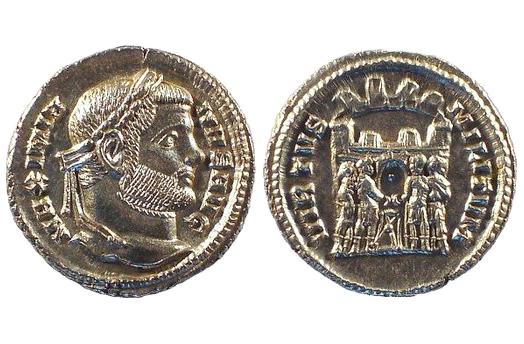
about ancient nomos
Ancient Nomos Art is a museum of galleries exhibiting ancient coins and ancient mint maps. The coin gallery displays the diverse art and history of hand-crafted ancient Greek, Roman, Byzantine, Persian and Medieval coinage. The ancient mints mapping gallery features Greek, Roman, Byzantine, Asia Minor and Medieval mint city regions and territories. Visitor's are welcome to explore, study and enjoy Ancient Nomos Art.

Imperial, Rome – 294 AD
Maximianus
From Ancient Galleries

Obverse: Laureate bust of Maximianus as "Augustus" facing right with full beard.
Reverse: Four Tetrarchs sacrificing over tripod at eight-turreted campgate arch.
LEGEND
Obv. IMP*MAXI NVS AVG, Laureate bust of Maximianus facing right during his first reign as 2nd tetrarch in command. Rev. VIRTVS MILITVM, Four tetrarch Emperors sacrificing over tripod before the camp-gate archway, with an eight turreted stone enclosure above.
Co-Emperor Maximianus, named Marcus Aurelius Valerius (Herculius), was born of peasant family origin at Sirmium in Pannonia. He served in the Roman army as a young man and achieved distinction as an intelligent and loyal comrade alongside Diocletian’s command. After Diocletian was declared Emperor in 284 AD, he assigned Maximianus as subordinate co-ruler with the title of Caesar 285 AD. After Diocletian divided the Roman empire into east and west regions, Maximianus was named co-ruler in 286 AD and received the title of “Augustus” of the western empire. In 293 AD, Diocletian and Maximianus declared two junior “Caesar” sub-emperors would assist in running the Empire. This new governing structure of four is known as the Tetrarchy. Maximianus was assisted in the west by Constantius Chlorus “Caesar” and Diocletian was assisted by Caius Galerius “Caesar” in the east. The above coin was issued to give legitimacy to the Tetrarchy form of governance. Even the coinage was given a new name of Argenteus (See Diocletian). It was struck at the Siscia (Sofia) mint in 294 AD. The coins obverse depicts a laureate bust of Maximianus facing right. The Latin legend inscribes his name and his title of Augustus. The coins reverse is the first time a Tetrarchy image is depicted on a Roman coin. The four Tetrarch rulers are seen for the first time standing before a camp (or city) gate. As the four rulers stand guard, symbolically protecting entry to the empire or military camp, they are also conducting a ritual military sacrifice over the sacred Roman tripod. The scenes background depicts a protective stone enclosure with eight lookout turrets built above the walls. The reverse Latin legend, VIRTVS MILITVM, translates to mean “Bravery of the Soldier.” On May 1, 305 AD, both Diocletian and Maximianus announced their successive retirements in an unprecedented resignation of imperial leadership the Empire had not previously witnessed. They leave the tenuous Tetrarchy succession to their juniors comrades Constantius and Galerius, now each newly named “Augustus” co-leaders of Rome.
DOCUMENTATION
Value: Argenteus. Metal: AR Silver. Weight: 3.34 grams. Mint: Siscia. Date: 294-295 AD.
Attribution: Roman Imperial Coinage, VI 43b; Jelocnik 12a; RSC 625f.
Legend, Documentation and Attribution
